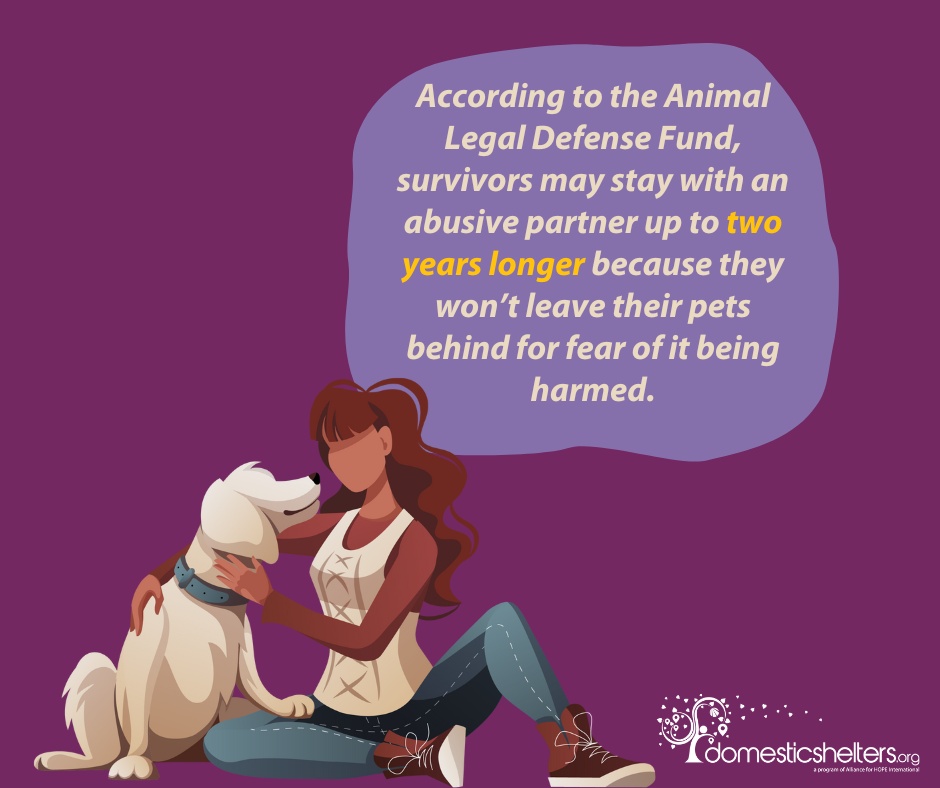1. Select a discrete app icon.

notes
Saving Pets (and Yourself) from Domestic Violence
Animal abuse often goes along with domestic violence, and both humans and pets deserve to get out safe
- Apr 15, 2024

This piece was originally published in 2015. It was updated in 2024.
Animal abuse and domestic violence are intricately, and sadly, linked. Animal abuse is a form of intimidation found on the power and control wheel, a tool used by advocates of domestic violence to explain how most abusers attempt to control their victims. Oftentimes, animal abuse is not a problem with temper or anger management, but rather a way to establish power over a human victim by killing, harming or threatening to harm their pets and rob survivors of the comfort they provide.
According to the Animal Legal Defense Fund, abusers of animals are five times as likely to harm humans and survivors may stay with an abusive partner up to two years longer because they won’t leave their pets behind for fear of it being harmed. Those fears are founded: Studies indicate that anywhere from 48 percent to 71 percent of abuse survivors have pets that also have been abused or killed by the woman’s partner.
State and Federal Laws are Looking Out for Pet Safety
Advocacy groups and lawmakers are paying attention and want to protect these four-legged family members.
PAWS Act
In 2018, the PAWS Act (Pet and Women Safety) was signed into law as part of the 2018 federal Farm Bill. This bill expanded existing federal domestic violence protections to include pets and authorized $3 million a year in grants for emergency and transitional housing assistance for survivors with pets. In addition, the PAWS Act added a provision to the federal stalking law that includes threatening of pets as a form of stalking. The Act also makes sure vet bills are a part of crime victim compensation on a federal level.
PACT Act
In 2019, the federal PACT Act—which stands for Preventing Animal Cruelty and Torture—was signed into law, making animal cruelty a federal felony.
Under the PACT Act, a person can be prosecuted for crushing, burning, drowning, suffocating or impaling animals or sexually exploiting them. Those convicted will face federal felony charges, fines and up to seven years in prison.

Protection Orders
As of 2021, 36 states, the District of Columbia and Puerto Rico have laws that permit pets to be included in protection orders. According to the Animal Welfare Institute, even if a state does not have a pet protection order statute, a survivor can include in their protection order application incidents of pet abuse or threats of pet abuse and request that the court include them in the order. Survivors can also petition the court to assist with removing the pet safely from a home where an abuser is located.
How to Prove Pet Custody
It’s crucial to be prepared for court when you’re trying to keep your pet with you and escape an abuser. Courts may want to see proof that you were the original owner of the pet or provided the majority of its care while it was in a shared home. Compile as much of this kind of paperwork as possible:
- Any documentation showing you adopted or purchased the pet originally.
- An animal license registered with your name as the owner.
- Vet bill receipts in your name.
- Other pet-related expenses that you’ve paid for such as grooming, boarding, food, classes or supplies.
- Any documentation that shows that you, the survivor, spent the majority of the time with the pet or kept the pet after a separation.
Additionally, you may be able to have witnesses testify that they saw you were the one who provided consistent care for the pet or that they witnessed abuse of the animal by the other partner.
More Domestic Violence Shelters Becoming Pet Friendly
If you need a safe place to go after leaving an abuser, a domestic violence shelter may be an option. Luckily, an increasing number of shelters are now welcoming pet survivors along with their humans. By the end of 2025, the nonprofit RedRover has made it their goal to help 25 percent of domestic violence shelters become pet-welcoming.
“Pet-friendly” goes beyond your typical dogs and cats—most shelters that welcome animal family members also help survivors make accommodations for animals like horses, farm animals, fish, lizards, snakes—you name it, and the shelter will likely have an option for keeping it safe. (Just make sure you have updated vaccination records at the ready.) You can search for pet-friendly shelters on our Get Help page by entering your ZIP code and then choosing pet-friendly options in the filters.
Other Routes to Keep Pets Safe from Abusers
If a pet-friendly shelter isn’t an option near you, what else can you do with pets? Avoid leaving your pets with an abusive partner if at all possible. Not only are the animals at risk, but they’ll also be used as a leveraging tool by the abuser to get you to return. Consider these possibilities:
- Talk to your veterinarian. Your vet may have referrals to emergency boarding options in your area, or who may even know someone who can help temporarily foster your pets until you can find a safe place.
- If your pet is microchipped, make sure the abusive partner is not listed as one of the contacts.
- After you relocate or leave an abuser, consider changing vets, doggy day cares, boarding facilities, dog parks, etc. where the abuser would know to look for you.
- Take precautions in leaving a pet outside unattended for any length of time if you feel like your abusive ex may know where you are.
Finally, don’t underestimate the effect trauma can have on your pet. Give your pet plenty of time and space to heal, just as you, the survivor, need as well. It’s not abnormal for a pet to hide for a few days or weeks until they come to trust they’re safe again. Try to interact with them as calmly as possible. The Central California SPCA offers up some tips to help calm anxious dogs (but these may work for cats as well. Lizards, we’re not sure about).
Donate and change a life
Your support gives hope and help to victims of domestic violence every day.
Looking for someone to speak with? Enter your location to find phone numbers for domestic violence experts in your area.
Have a question about domestic violence? Type your question below to find answers.







